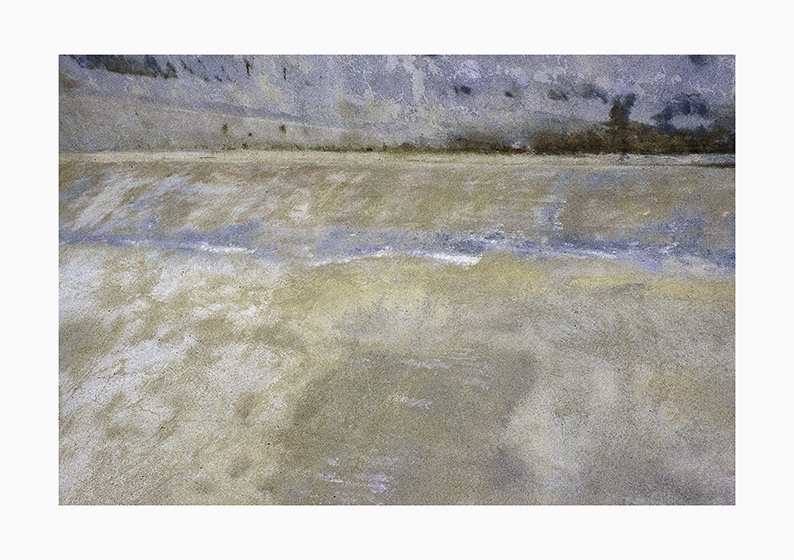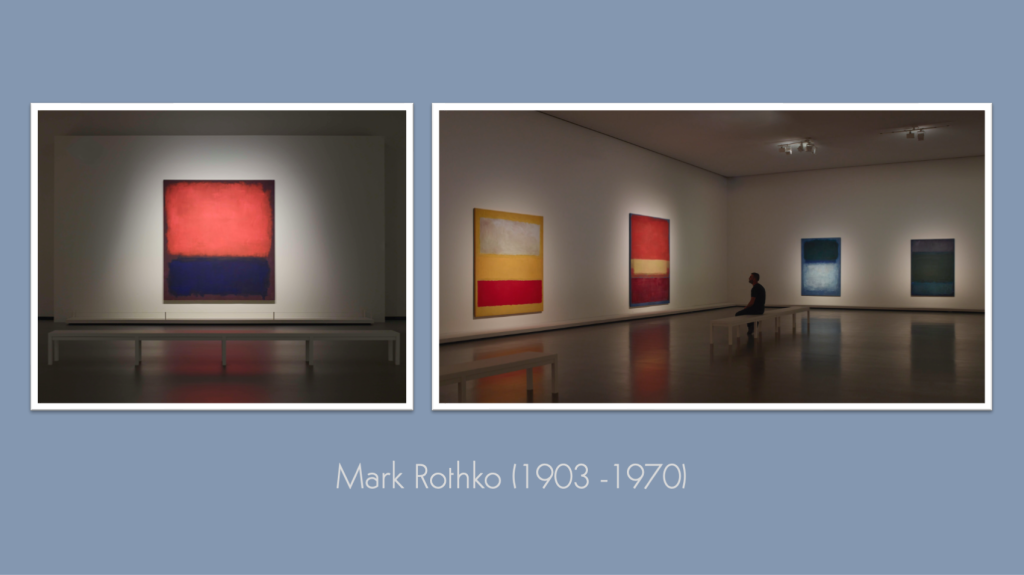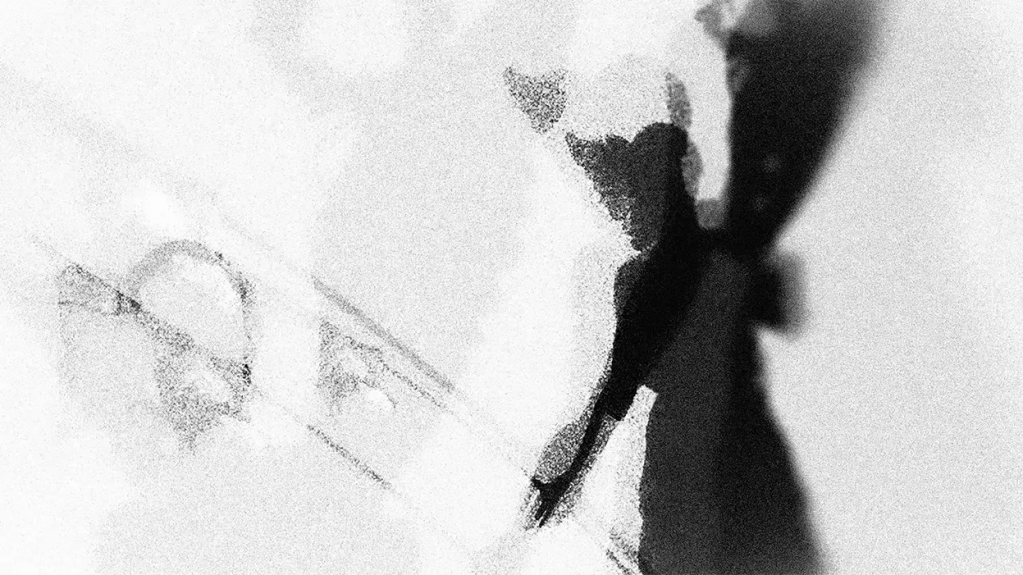Charles Sheeler, our prompt for our previous Kick-About, transformed his man-made landscapes into flattened, graphical patchworks. Klimt’s painting, Tannenwald is similarly transformative, magicking a forest of ubiquitous pine trees into something as tactile and richly textured as tapestry and is this week’s muse. Happy browsing – and you’ll find all previous editions of The Kick-About here.
Vanessa Clegg
“This began as a photo I was given a while ago, so, after ripping it up and reassembling, it reminded me of those infuriating ball games where you have to get all the balls into all of the minuscule dips… Then, looking at Klimt’s painting, the fragmented style of tiny brush marks drew me towards the cake decorations: hundreds and thousands so… with a Pritt Stick and sprinkles, I attempted to reconstruct (or is that deconstruct?) the artwork. Not altogether successful, but a good session of ‘playtime’, and, if cakes are ever baked in this kitchen, I’ll be prepared!”


Phil Cooper
“I love Klimt’s landscape paintings more than his super-famous images with figures (that fetch a lot more money at auction but give me one of the landscapes any day). His sense of colour and the mysterious beauty with which he imbues the trees and flowers is rather magical.
Berlin is surrounded by forests. There are some particularly fine old beech forests about a couple of hours north of the city. But for my response this week I’ve gone small scale and made images of a nest made of twigs I found on my balcony. I noticed a wood pigeon flitting about on the balcony the other day and when I went to trim the broom that had finished flowering, I found a nest. Unfortunately, the pigeons took fright at my bobbing about so much and they abandoned the nest. I photographed it and played around with the photos. I’d like to move on a step from the photos to draw from them, something on big sheets of paper with charcoal. It wasn’t a very elaborate nest – pigeons really are pretty lazy at this, a few twigs plonked on a surface, and they’re done – but I liked the idea that these twigs would create a protective space for the eggs to be laid and the new chicks to hatch. The twigs will then get blown away and rot down into the earth to feed the trees that make more twigs for more nests, on and on…”


instagram.com/philcoops / hedgecrows.wordpress.com / phil-cooper.com
Francesca Maxwell
“Fabulous painting by Klimt, just the kind of world I see and paint. He uses the dotted, fragmented brushstrokes to create the light and texture with beautiful contrasting colours. I tend to use lines to create a similar effect and I like to play and explore the incorporeity of objects and their interaction with the background. Here is my version of a pathway in the woods.” Acrylic ink on watercolour paper, 76×56 cm.

Jan Blake
“The first question I asked myself was ‘what is the difference between a forest and a wood’, as the Klimt painting suggests tall forests of straight, giant pine forests glowing in dappled Autumn light. The answer was we have fewer and smaller areas that can support species such as heaths, open grassland and farmland, of which forests are part. The term woodlands is considered to be land covered with trees and vegetation, but in the UK tend not to be as large as forests elsewhere in Europe. Most of the pine forests are in Scotland and they still have game to hunt there. The pencil drawing I have made is my view of a ‘plantation’ of new trees of the same species on the Burton Agnes estate in Yorkshire. I think they are ash trees and the repetitive nature of their arching limbs and the grasses between them, as if at sea, captured my love of movement, a complete contrast to the stillness of the Klimt. However, I couldn’t help sharing this photo of a new woodland I helped to plant and nurture that relates more to the Klimt painting. When it matures, the mixture of species will give a completely different aspect of tangled branches and non-uniform shapes.”


Charly Skilling
“I was thinking about Klimt’s ‘Tannenwald’ whilst playing with some oil pastels and ended up with a sketch that was recognisably “woody” but offered little in the way of texture. However, it did suggest a possible means of using yarns of differing weights and ply to build the textures (and colours) that I sought. The different tensions within the fabric, created by using different yarns, caused the shapes to twist and contort, producing trees more reminiscent of ancient woodlands and fairy tales than Klimt’s pines. It felt more like ‘tree-wrangling’ at times than crochet, but I learn new stuff with every Kick-About. ”








Kerfe Roig
“One thing that struck me about all the reproductions of this painting is the wide variation of color. I’m sure none are ‘true’ to the actual work. I wanted to do some embroidery, but got little done. I think the concept was valid, the execution not so much. I’m not sure where it will go next. I may pull some of the ground stitches out to begin with. Just part of the creative process: it happens often to me, anyway, roads that end up going nowhere. But you always learn something.”
always un
finished, the hand’s work
wandering
through mind’s eye–
branching off, elusive, en
igmatic as time



kblog.blog / methodtwomadness.wordpress.com
Phil Gomm
“So not a pine forest, but a beech wood carpeted with bluebells. These photographs were produced by over-exposing a lot to introduce lots of white into the image and blow out the details to produce as impressionist a vibe as possible. The leaves on the trees themselves were innately pointillist because they were small, trembling and translucent and the bluebells themselves didn’t seem credible at all – all that consistent colour, and so much of it. The moodier images were over-exposed to push the highlights of the leaves, which appeared to float like shoals of neon fish in the darker bits of the wood, and then the shadows were pulled back into the image for contrast.“





Marion Raper
“I have a fascination for any type of trees and really enjoy painting branch shapes and the spaces between them. I know Klimt was more about straight tall pine trees, but I just prefer more movement. In my garden I have two twisty old hawthorn trees with a holly tree between them, which I used as my reference. After painting them I added some gold patterned paper. It turned out more like Clarice Cliff unfortunately! But hey, it was really satisfying to do.”





James Randall
“Klimt was a young James’ favourite – all that pattern and vibrancy. I tried to sketch up a photo of a tree on the way to a ramshackle holiday rental in a national park along a well rutted sandy dirt road, all gridded up and from a photo. I stopped before adding the tree textures for this image. The trees were black-barked and very dramatic. I hope to paint it up as a momento from one of those blue sky magic moments in life when all seriousness is shed (probably bounced off along that torturous dirt road!).”

Graeme Daly
“I’ve always been fascinated by the detailed scratchings of birch trees, like little beady eyes amongst the white trunks. Back home in Ireland, down a picturesque route swarmed by sleepy sheep, there is a gorgeous forest of sitka spruces and birch trees. My neighbours don’t bat an eyelash when I hop over the fence with my camera in hand. I took a bunch of these photos at different times of the year and made an impressionistic mixed media series a while ago called Lenticels, where I painted over the photos, mimicking the same textures to encapsulate my impressions of this magical place. I loved this series and happened to take more photos this past winter and made a few more to add to the series for this week’s Klimt prompt.”














@graemedalyart / vimeo.com/graemedaly / linkedin.com/in/graeme-daly / twitter.com/Graeme_Daly / gentlegiant.blog
And you never know; if you look into Klimt’s pine forest very closely, you might just see a jabberwocky lumbering between all those tall, straight trees… Beware!









Leave a comment